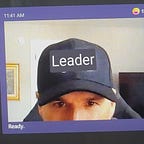Strategy Isn’t Straight Lines
It looks more like a spider web.
There is a simple strategic formula I like to follow.
Focus = Set priorities.
Align = Get everyone on the same page.
Execute = Make it happen.
But, I’ve learned,
it looks more like…
Focus
Align
Align again
Refocus
Align some more
Execute for while
Refocus
Align again
etc.
There are many formulas available for how to create a great strategy and many of them read like a linear process.
In reality, a strategy is more like a web with many interconnected points and the strategy at the center. And a leader’s job is to make sure those points stay connected amidst a constant stream of internal and external pressures trying to pull them apart.
Once things have come off the rails, it can require enormous effort to get things back on track. That’s why it is important to observe the warning signals and act before they become apparent to everyone else and put your objectives at risk.
This requires a certain kind of intentional awareness. Many leaders think their job ends with the launch. They move on to the next initiative, only to get sucked back in to do repair work which ends up slowing down progress.
This isn’t to suggest that a leader should micromanage or try to stay on top of every detail. It’s more subtle. The key is not to try and consume all the noise of the organization but to tune in to important frequencies.
For example, it might be important to check in regularly with a few key people that you know have the pulse of the organization and the key initiatives that are in progress. This isn’t a formal business review, rather an informal conversation.
Another method of staying connected is to set short-term targets or milestones that allow you to monitor progress across multiple variables in smaller increments. These can be organized into a visual dashboard that you can monitor and then follow up on specific areas that need attention.
Periodic formal checkpoints can also be useful to gauge progress but use these carefully. Depending on your role, the culture, and how you set up the meeting, you can end up with a bunch of people telling you what they think you want to hear. Another risk in waiting for formal reviews is that a lot can go sideways while you aren’t paying attention, even over a short period.
Then there are the less-obvious cues you can pick up spontaneously from emails, conversations around the office, feedback from customers, meeting calendars, etc. Sometimes these are the most valuable signals and require you to learn the unspoken language of the organization.
They tell you where the energy is flowing and what is consuming time and resources. You may pick up signals here that will not be disclosed elsewhere and get a sense of how people are feeling not just what they are doing.
And how they are feeling matters a great deal in achieving your goals.
The challenge is to make many small adjustments and course corrections which can be managed with less effort and impact to the organization versus wild swings and reactionary responses that throw the organization off balance. Instead of grabbing the wheel and yanking the car back on the road and into the other lane, you are focused on keeping it between the lines.
Great things are not done by impulse, but by a series of small things brought together. — George Eliot
Most spiders respin and repair their web daily. They sense even the slightest vibration in or change to their web and work to constantly maintain their environment to ensure their survival. While it may look like they are just chilling there waiting for the next bug, there is a lot more going on when you aren’t watching.
The web works because the spider does the work necessary to make sure that everything stays connected and attends to the constant changes created by its environment.
Leading a successful strategy is much more than giving people marching orders. It requires constant tending, recalibrating and attention to the details. If you are too busy to care for the strategy day to day, then don’t be surprised when you find you are on the right course for the wrong destination.
Need help, have questions or feedback? You can contact me at scottmabry@mail.com. You can also follow me on Twitter or LinkedIn.
Note: All content I create here is my own and does not represent the opinion of any organization.
